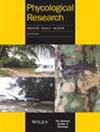利用性别特异性分子标记对褐藻 Dictyota dichotoma(Dictyotales, Phaeophyceae)的相位和性别比例进行实地调查
IF 1
4区 生物学
Q2 MARINE & FRESHWATER BIOLOGY
引用次数: 0
摘要
据报道,在各种同形大型藻类中,一种阶段(即二倍体或单倍体)占优势;然而,由于难以确定不育藻体的阶段,对两种阶段相对频率的研究仅限于少数类群。在 Dictyota dichotoma 中,我们以前曾记录过可育孢子体占优势的情况。在本研究中,我们使用新开发的性别特异性标记确定了 D. dichotoma 不育毛球的阶段和性别比例。通过对雌性和雄性配子体菌株以及一个孢子体菌株进行转录组分析,检测了不同表达的基因,旨在找出候选的性别特异性基因。这些候选基因与硅藻性染色体上的基因组序列进行了比对,并被确定为 D. dichotoma 的推定性别特异性基因。设计了两组引物,通过 PCR 产物的有无来区分阶段和性别,并将这些标记用于研究 D. dichotoma 在不同生境和季节的阶段和性别比例。在静冈县惠比寿岛的五个栖息地中,每个栖息地的孢子体占 33-50 个毛体的比例为 88%-100%,可育孢子体占总孢子体的比例(可育比例)因栖息地而异(0-54%)。可育孢子体明显大于不育孢子体。在千叶县馆山,孢子体在所有季节都占优势。孢子体的生育率在 2 月(62.4%)至 5 月(91.9%)期间相对较高,在其他季节则低于 23%。当人工基质固定在 D. dichotoma种群的中间时,新采集的毛球都是孢子体,这表明自然界中通过四孢子繁殖的情况并不频繁。基于这些发现,我们讨论了 D. dichotoma 不同阶段之间的潜在适应性差异。本文章由计算机程序翻译,如有差异,请以英文原文为准。
Field survey of the phase and sex ratios of the brown alga Dictyota dichotoma (Dictyotales, Phaeophyceae) using sex-specific molecular markers
Dominance of one phase (i.e. diploid or haploid) has been reported in various isomorphic macroalgae; however, studies of the relative frequencies of the two phases are limited to a few taxa owing to the difficulty in identifying phases of sterile thalli. In Dictyota dichotoma, we have previously documented the dominance of fertile sporophytes. In the present study, the phase and sex ratios of sterile thalli of D. dichotoma were determined using newly developed sex-specific markers. Differentially expressed genes were detected by transcriptome analyses of female and male gametophytic strains and a sporophytic strain aiming to identify candidate sex-specific genes. These candidates were aligned with genome sequences on the sex chromosomes of Ectocarpus siliculosus and were identified as putative sex-specific genes of D. dichotoma. Two primer sets were designed to discriminate phase and sex by the presence or absence of PCR products, and these markers were applied to examine the phase and sex ratios of D. dichotoma in various habitats and seasons. The proportion of sporophytes against 33–50 thalli examined in each of the five habitats at Ebisu Island, Shizuoka Prefecture was 88–100%, and the proportion of fertile sporophytes against total sporophytes (fertility proportion) varied among the habitats (0–54%). The fertile sporophytes were remarkably larger than the sterile sporophytes. At Tateyama, Chiba Prefecture, the dominance of sporophytes occurred in all seasons. The fertility proportion of sporophyte was relatively high from February (62.4%) to May (91.9%) and lower than 23% in other seasons. When artificial substrates were anchored in the middle of the D. dichotoma population, newly recruited thalli were all sporophytes, suggesting infrequent reproduction via tetraspores in nature. Based on these findings, we discuss potential fitness differences between the phases of D. dichotoma.
求助全文
通过发布文献求助,成功后即可免费获取论文全文。
去求助
来源期刊

Phycological Research
生物-海洋与淡水生物学
CiteScore
3.60
自引率
13.30%
发文量
33
审稿时长
>12 weeks
期刊介绍:
Phycological Research is published by the Japanese Society of Phycology and complements the Japanese Journal of Phycology. The Journal publishes international, basic or applied, peer-reviewed research dealing with all aspects of phycology including ecology, taxonomy and phylogeny, evolution, genetics, molecular biology, biochemistry, cell biology, morphology, physiology, new techniques to facilitate the international exchange of results. All articles are peer-reviewed by at least two researchers expert in the filed of the submitted paper. Phycological Research has been credited by the International Association for Plant Taxonomy for the purpose of registration of new non-vascular plant names (including fossils).
 求助内容:
求助内容: 应助结果提醒方式:
应助结果提醒方式:


